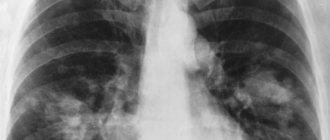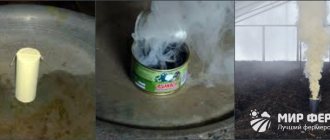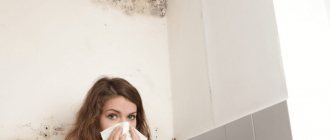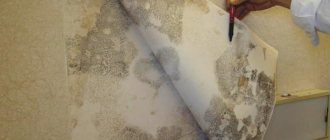Common causes of mold
Why do slopes on plastic windows turn black and stains appear on the windowsill? There are some reasons for this.
Firstly, old wooden windows had slits that allowed air to circulate in the room. Yes, there were drafts and heat loss, but the humidity was normal. As soon as the frames were changed to PVC, the situation changed: the movement of oxygen stopped and favorable conditions were created for the development of fungus on the slopes of plastic windows.
When installing plastic frames, air circulation stops
Secondly, in order for mold to multiply at tremendous speed, two important factors must be provided - humidity and heat. Wood let condensation through and evaporated it, while plastic does not do this due to its tightness. In addition, there is often a violation of the installation technology of PVC windows; in this case, water collects on the frame and contributes to the development of a harmful environment.
Simply washing off the mold that has appeared on the window slopes is not enough: you need to eliminate the reason why it appears, otherwise everything will repeat itself.
Fungus and mold on windows: additional causes of condensation
Let us repeat that constant moisture on windows leads to the growth of fungal spores. Plastic windows are more susceptible to this due to the tightness of the frame itself. But it is worth highlighting the reasons that many overlook, and they apply to any windows.
Additional reasons why fungus and mold appear on windows:
- Incorrect installation or assembly of the structure itself. That is, if there are cracks or emptiness between the frame and the wall, then there will be a constant draft in the house
- Insufficient layer of polyurethane foam. Or has it dried out over time?
- If the cleaning was initially done poorly and the foam did not stick well
- When the window sill is not used and water accumulates under the frame
- Distortion of the frame itself due to insufficient use of dowels or too wide a distance to the slopes
- If the window was installed directly on the insulation without wedges
- Gaps or cracks in the wall
- The window sill and slopes are too wide. A large window sill blocks the circulation of warm air from the radiators in order to properly dry the window from condensation
- Insufficient radiator/heating radiator
- The curtains are too thick, which also blocks the air to the window
A large number of flowers increases humidity and interferes with circulation
How and with what to eliminate mold on the slopes of PVC windows
What to do if mold appears on the slopes of a plastic window, how to deal with it? You need to prepare equipment and means to treat the surface. It can be:
- antifungal solutions for surface treatment;
- detergents containing chlorine;
- personal protective equipment (gloves, respirator, etc.).
Antifungal solutions are used to treat the surface.
If you have to disassemble the slope, then prepare:
- drill, spatula, chisel;
- screwdrivers, ruler, pencil and tape measure;
- thermal insulation material;
- sealant, foam, mastic;
- plastic panel, starting strip;
- knife and glue for plastic.
The war against fungi is carried out in several stages. How to permanently remove mold from the slopes of plastic windows, what to do to prevent its occurrence?
Surface cleaning
Pay attention to the material with which the slopes on the windows are sewn after installation. How to get rid of mold on slopes if it is plastic that has stains? You should remove the panel and disinfect the wall underneath it. When covering a slope with plasterboard, you will have to remove it completely and replace it with a new one, since the mold has penetrated deep into the material, from where you cannot remove it .
At the first stage, the surface is disinfected.
Using a brush, clean the frame and slope from fungus and treat with a bleach solution, be sure to wear gloves. After carrying out such procedures, ventilate the room.
Surface treatment with antiseptic
You can buy ready-made products at hardware stores. These compounds are made on the basis of chlorine or copper sulfate. In addition, you can make the product yourself, for example, take 70% acetic acid 0.2 l, add boric acid 0.2 l and dilute 1 l of water. Second option: take 0.1 liter of sodium fluoride, add 0.1 liter of copper sulfate and dilute it with 1 liter of water. You can take copper sulfate and bleach 1:1 and dilute it with 5 parts of water.
To combat mold, you can prepare a solution of copper sulfate and chlorine
The antiseptic is applied with a brush to the entire surface, be sure to wear gloves on your hands, and after treatment the room is ventilated.
Consolidate the result
To prevent mold from appearing, it is necessary to waterproof the area. For this purpose, mastic is suitable, which covers the entire surface of the wall to be treated, making it waterproof and can last for several years.
Waterproofing the slope will protect the structure from mold for several years
After carrying out the manipulations, if the result is not achieved, you can try to make ventilation ducts in the upper part of the window or you will need to drill a hole in the window sill that covers the battery.
There are several remedies that will remove fungi:
- Antiseptic primer. The use of such a product during construction and finishing work prevents the formation of fungi.
- Bleach. Chlorine-based products, which we regularly use to clean and wash windows, are excellent antiseptics.
- Vinegar or citric acid. This product, which is found in every kitchen, can help in the fight against harmful fungi.
- Hydrogen peroxide. Many types of fungi die upon contact with this drug, in addition, it is not toxic to humans.
- Ammonia can help if fungus has appeared on a smooth surface, glass or tile.
- Baking soda. Having prepared an aqueous solution, you can treat stains, but there is no need to wash it off, because soda does not harm the materials.
- Borax. The natural material dissolves in water and is applied to the surface affected by the fungus. There is no need to wash it off.
- Tea tree oil or grapefruit seed extract. Dissolve in water and apply by spraying onto a plane with mold.
- Sometimes they use potassium permanganate in solution or office glue diluted with water.
It is recommended to apply the antiseptic several times.
Whatever product is chosen, you need to know how to remove mold from slopes.
Thoroughly clean the surface and apply the antiseptic several times, then a long-lasting effect will be ensured.
How to remove fungus and mold on windows: a review of the best chemicals
You can buy a product to remove mold and mildew from windows at any hardware store. Moreover, they are suitable for working on any surface - concrete, brick, plasterboard, plaster or paint, ceramics, stone or wood. We offer a list of the best anti-mold drugs:
- Olympus stop mold
- Metas- BIO
- Tex
- NANO-FIX
- Abedis 06
- Fongifluid Alpa
- SCHIMMEL-ENTFERNER
- Dali
- Dufa
- Vincents Polyline
Review
You should be careful with plastic windows - against strong agents, and with prolonged exposure, the plastic may turn yellow. Therefore, it is better to choose the following means, since they are less aggressive:
- NEOMID Bio
- Biotsid-S
- Mellrud
- Tilex
- HG
Important : Take precautions, cover your eyes, head and hands! And always follow the instructions! Before purchasing, find out the degree of toxicity of the drug, whether it can be used indoors or on a certain surface, and how it affects animals.
Typically, chemicals are sprayed and removed along with the mold. If necessary, the procedure should be repeated to remove mold to the base. Then an antifungal primer is applied.
Treat every area
Rules to prevent mold growth
There are some points that must be observed to ensure that black streaks of mold do not appear on your windows. These rules must be followed constantly.
- Do not block the ventilation opening in the kitchen with furniture. In this room, elevated temperatures are most often observed. If you close the ventilation grille, this will impede circulation;
- Check your plastic windows at least twice a year and take care of them. It is necessary to make sure that the fittings are in good condition, sealing, and the cleanliness of the slopes and frames. If you discover a small defect or breakdown, try to seek help from a technician as quickly as possible or fix the problem yourself. It is better to carry out timely repairs and maintenance of plastic windows than to get rid of the fungus later;
- there is no need to grow indoor plants in large quantities; they also help increase the humidity in the room;
Flowers on the windowsill can cause fungus to appear on the slopes - if there are interior doors in the room, try to open them and keep them open - this also promotes air circulation;
- Ventilation is necessary. This is worth doing every day. A good option would be to have an air conditioner;
- try not to dry clothes indoors with the windows closed;
- do not forget to regularly treat the surface of windows with products that contain chlorine.
The most important companion of mold is condensation. If you notice its appearance, inspect the window frame. Pay attention to the bottom corners. If you find blackheads, you need to start fighting them. Wash them off with a special solution or treat them with bleach.
Constant fogging of the window can lead to the appearance of mold.
You can purchase an antiseptic primer and cover the areas where mold has appeared with it, leaving the treated layer for 2 days, then rinse with water.
Home / LIFE HACKS
116
SHARES
ShareTweet
Today, plastic windows are not considered a luxury; they are installed for convenience and thermal insulation. Double-glazed windows are installed in industrial and residential premises, offices and even greenhouses. Plastic windows have their advantages and disadvantages. The latter include the appearance of fungus on the slopes and frame. Mold spreads in a short time and is not aesthetically pleasing. It is for this reason that many housewives want to quickly get rid of the outbreak of bacteria. There are many ways that we will talk about today.
Causes of mold
- Insufficient ventilation. Poor circulation leads to air stagnation and increased humidity. You can often smell an unpleasant odor coming from the room. Double-glazed windows do not allow air to pass through, this is a plus and a minus at the same time. To eliminate the negative side, you need to equip the room with good ventilation or open the windows more often. Synthetic curtains, a wide window sill and slopes significantly impede access to oxygen.
- High humidity. Due to the thermal insulation properties of the material, condensation forms on the surface of the windows. It accumulates first in the lower part, then goes down to the corners. Plastic cannot evaporate moisture, unlike wood. If we add to the above the incompetence of specialists in installing double-glazed windows, the tightness is broken. The water stagnates, allowing bacteria to multiply at double speed.
How to clean mold on plastic windows
- Chlorine-containing preparations. Products like chlorine not only eliminate mold, but also allow you to disinfect the room. Bleach needs to be diluted. For 100 ml. the drug is about 500 ml. water. Before treating moldy areas, wear a miniature respirator and protect your hands with gloves. Whiteness kills the fungus immediately, so there is no point in keeping the product for a long time. The harsh composition of the bleaching product has a detrimental effect on the decor. There is no need to use bleach when removing mold from the front parts of double-glazed windows.
- Copper sulfate. The product is sold in hardware and gardening stores. As with bleach, you should wear rubber gloves and protect your respiratory tract before handling. Next, the composition is distributed onto a sponge, and the frames, window sills, slopes, and glass are already wiped with it. Do not distribute vitriol on metal elements, so as not to cause premature corrosion. Upon completion of cleaning, ventilate the room for 1 hour.
- Bleach and vitriol. If you need to eliminate a large amount of mold that has managed to affect the inner layers of the material, use the mixture. Combine a chlorine-containing preparation and copper sulfate in equal quantities. Dilute with water, 1 liter. liquid is 200 ml. mixtures. Put on a respirator, protective gown and gloves, and begin eliminating the fungus. Wipe window sills, frames, slopes, leave the composition for a maximum of 10 minutes. Always complete cleaning with normal washing.
- Table vinegar. To eliminate the source of infection, you can use undiluted vinegar. First, wipe the mold damage with a dry cloth, then spray vinegar on the affected areas. Try to distribute as much of the composition as possible. After 2 hours, blot with napkins and rub the moldy area with a sponge. If the fungus is not completely removed, repeat the steps again.
- Hydrogen peroxide. Prepare a paste of baking soda and filtered water. Spread the mixture over the moldy areas, then pour the hydrogen peroxide into a spray bottle. Spray the area treated with soda with the product. You will notice that the substances have reacted. Bubbles will appear on the surface. As soon as the hissing stops, note the time and wait a quarter of an hour. After this period, remove excess with a sponge and wipe the surface with a cloth soaked in water. Open the windows and ventilate the room for half an hour.
- Soda. Baking soda kills the fungus immediately. Prepare a solution of 120 g. bulk product and 350 ml. water. Stir until the granules dissolve. Soak a rag in the mixture and walk over the moldy areas. Try scrubbing off the fungus. If it does not give in, apply a paste of soda and water to the difficult areas. Wait 20 minutes, remove dirt with dry wipes. Soda does not need additional rinsing if there are no gray marks left on the double-glazed windows.
- Detergents. If you need to remove mold, choose a product designed for cleaning plumbing fixtures or ceramic tiles. The following products have proven themselves to be excellent: “Silit Beng”, “Domestos”, “Sarma”, “Amway”, “Mr. Proper”, “Vanish”, “Eared Nanny”. At the pharmacy you can buy disinfectants such as NEOMide, BIOtsid, Clotrimazole, Candide.
- Tea tree ether. Many housewives use all kinds of natural oils that kill fungus. Buy tea tree, rosemary, geranium or patchouli ether at the pharmacy. All of the above products have bactericidal and disinfectant properties. Mix any oil with table salt in equal quantities. Grind into a paste and distribute over areas with mold lesions. Rinse off the product with plain water after half an hour.
Preventive actions
- To minimize the formation of fungus, you need to maintain the indoor microclimate. The humidity level should not rise above 35%. In this case, the optimal temperature is considered to be 20-22 degrees.
- Eliminate sources that cause high humidity. These include possible leaks at the joints of sewer pipes, frequent drying of clothes indoors, and accumulation of indoor flowers. Install a system that can condition and ventilate the air. If this is not possible, ventilate the room at least 3 times a day for 25-40 minutes (it should not be damp outside).
- Modern double-glazed windows are equipped with a handle that controls the window in two positions. During the cold season, turn the lever upward more often, ventilating the room using a small hole. If mold appears on double-glazed windows in the kitchen, install a hood. Use the device every time you cook food.
- You should not create soil for the development of fungus in the bathroom. Always use a plastic hood window, and after bathing, leave the door open until the moisture has completely evaporated.
- Synthetic and thick linen curtains hinder the operation of heating radiators. Warm air cannot get to the plastic windows to dry them and remove condensation. Change accessories with openwork light tulle.
- Carry out regular cleaning of windows, frames, slopes and window sills. The procedure is performed at least once a week, if possible more often. For preventative purposes, use a vinegar solution or baking soda mixed with water.
- If you notice that condensation often forms on the glass, remove it with a soft cloth. Try to keep double-glazed windows in a dry position to eliminate the possibility of mold.
- If the windows have been installed for a long time, check the rubber seals. Perhaps they are letting in moisture from the street.
Source
Click " Like " and get the best posts on Facebook!
Share on Facebook VKontakte Twitter Odnoklassniki
Preventive actions
Monitor the room temperature: it should not be higher than 22 degrees. Humidity should not exceed 60 percent. You can buy a special hygrometer in order to see the state of the environment in your apartment. Do not install a wide window sill that covers the battery. If all defects in the window design have been corrected, but the problem persists, it is worth looking into the ventilation system. You can install a ventilation or air conditioning system.
When cooking, turn on the hood. Don't forget about the bathroom, where you also need to ensure good ventilation; leave the door open after bathing. Try to clean windows regularly using special solutions. Regularly inspect frames, lubricate mechanisms and rubber gaskets.
To prevent the appearance of fungus and then not have to figure out how to deal with mold, it is best to install windows in the warm season. During installation, carefully blow out all the cracks with foam, and apply sealant to areas that cause suspicion.











